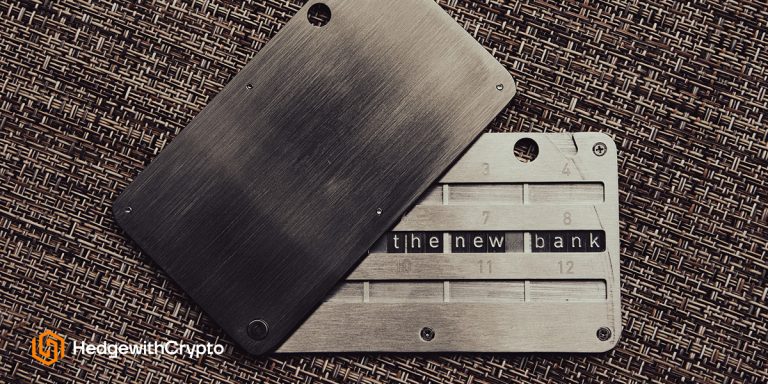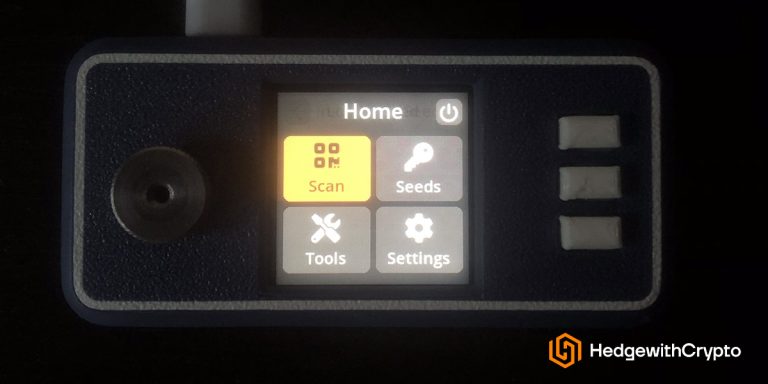We may earn a commission from links on our site, but this doesn’t affect our reviews. Learn more.
Hedge With Crypto is an independent publisher that provides objective and free content. Articles on our site may include links to our partners. If you click on these links, we may earn a commission. However, our editorial content remains unbiased, reflecting our own opinions or the general information available. For more information on our company policies, read the Affiliate Disclosure, Privacy Policy, and Terms & Conditions.
11 Best Hardware Wallets
Compare and choose a suitable hardware wallet to keep your digital assets safe.
Hedge With Crypto aims to publish information that is factual and accurate as of the date of publication. For specific information about a cryptocurrency exchange or trading platform please visit that provider’s website. This information is general in nature and is for education purposes only. Hedge With Crypto does not provide financial advice nor does it take into account your personal financial situation. We encourage you to seek financial advice from an independent financial advisor where appropriate and make your own enquiries.
TABLE OF CONTENTS
The best Bitcoin and cryptocurrency hardware wallets based on our reviews are:
- Ledger Nano X – Overall Best Crypto Hardware Wallet
- Trezor Model T – User-Friendly Hardware Wallet with Expandable Storage
- Ledger Nano S Plus – Great Budget Hardware Wallet
- Trezor Model One – Low-Cost Hardware wallet
- Keystone Pro – Touch Screen Hardware Wallet
- BitBox02 – Open-Source Hardware Wallet Device
- ELLIPAL Titan – 100% Offline Cold Storage Wallet
- NGRAVE – Premium Cold Wallet Storage
- SafePal S1 – Pocket-Sized Hardware Wallet
- CoolWallet Pro – Hardware Wallet with Staking Support
- KeepKey – Well-Designed Cold Crypto Wallet with In-Built Exchange
Featured Partner
Kraken
Crypto platform for smarter investing.
4.8 out of 5.0
Kraken is a US-based crypto trading platform that is best suited for users who need crypto-to-fiat and crypto-to-crypto trading facilities. One of the most regulated and security-focused exchanges, Kraken is a great choice.
200+
USD, GBP, EUR, CAD, CHF, JPY & AUD
Bank transfer, SWIFT, SEPA, debit and credit card
0.16% (maker) and 0.26% (taker)
Best Bitcoin Hardware Wallets Compared
| Wallet Name | Price | Supported Assets | In-Built Exchange | Connectivity |
|---|---|---|---|---|
| Ledger Nano X | $149 | 5,500+ | Yes | Bluetooth, USB-C |
| Trezor Model T | $262.80 | 1,456 | Yes | USB-C |
| Ledger Nano S Plus | $79 | 5,500+ | Yes | USB-C |
| Trezor Model One | $82.80 | 1,289 | Yes | USB-A |
| Keystone Pro | $169 | BTC, ETH, BCH, DASH, LTC, TRX, USDT, DOT, KSM +ETH and TRX Tokens | No | N/A |
| BitBox02 | $150 | BTC, LTC, ADA, and ETH-Based Tokens | Yes | USB-C |
| ELLIPAL Titan | $139 | 10,000+ | No | N/A |
| NGRAVE | $430 | BTC, ETH, BNB, XLM, SOL, ZEC, LTC, XRP, DOGE, BCH, DASH, XTZ, EGLD, and ETH-Based Assets | Yes | N/A |
| SafePal S1 | $49.99 | 54 | Yes | N/A |
| CoolWallet Pro | $149 | 27 + ERC-20, BEP-20, TRC-20 Tokens | Yes | Bluetooth |
| KeepKey | $49 | 2,534 | Yes | Micro USB |
Why We Picked These Hardware Wallets
We've included offerings from various providers at various price points in our reviews of the best hardware wallets.
1. Ledger Nano X
Ledger was founded in 2014 and has become ingrained in the crypto space thanks to the excellent security offered by the company's hardware devices. With ample storage space, ease of use, and a strong track record, the Ledger Nano X is commonly considered to be one of the best crypto wallets on the market. While the device is priced slightly higher than budget offerings, at $149, the Ledger Nano X is still more cost-effective than its main competitor, the Trezor Model T (priced at $262.80).
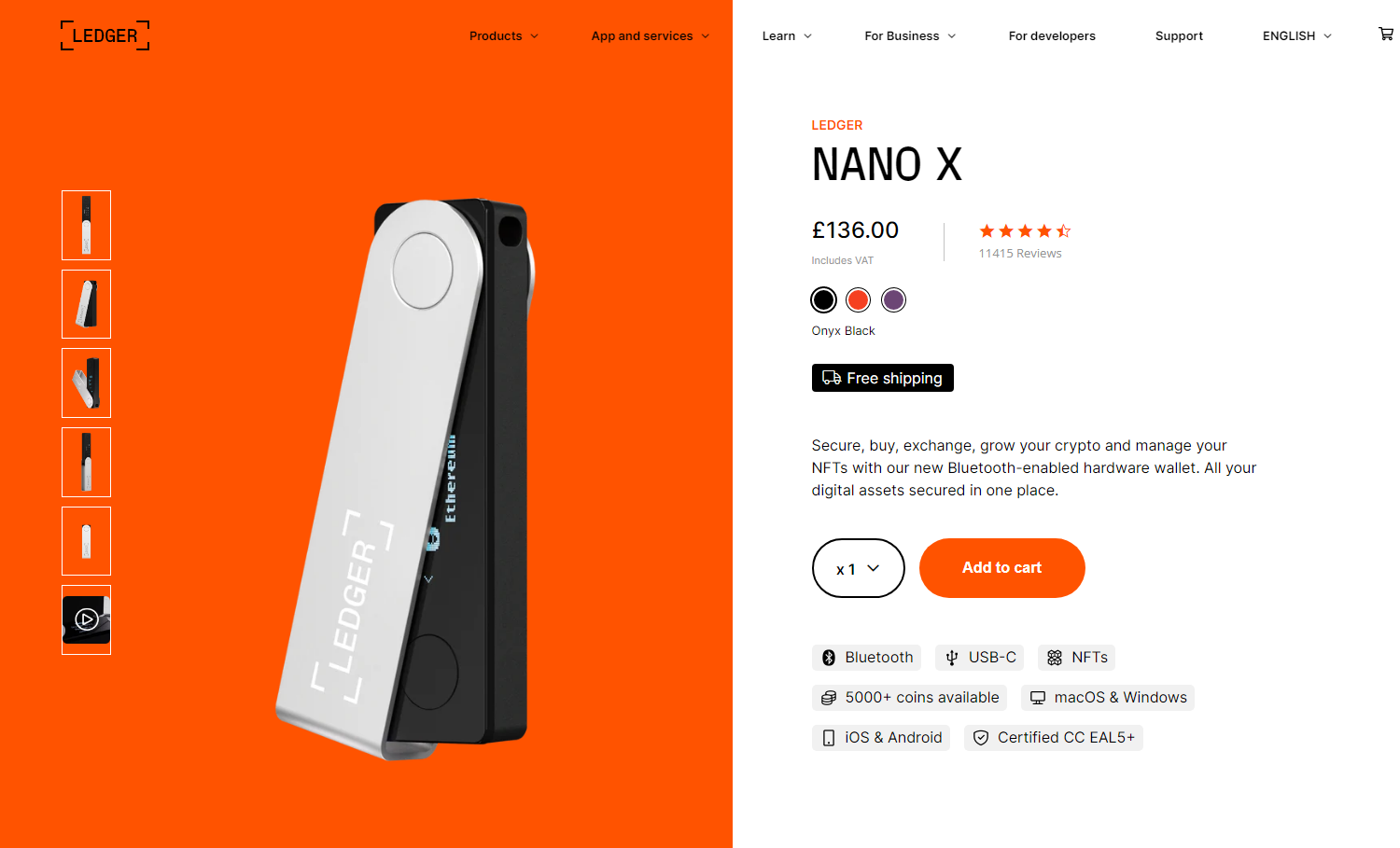
The Ledger hardware wallet is packed with valuable features likely to appeal to crypto enthusiasts of all preferences. With native NFT support, the ability to operate up to 100 wallets on a single device, and support for over 5,500 digital assets, the Ledger Nano X is a versatile device that deserves all the praise it gets.
The primary difference between the Nano X and the more budget-friendly Nano S Plus is Bluetooth connectivity and the inclusion of a battery, enabling the device to be used on the go. Moreover, every Ledger device has access to the Ledger Live app, allowing users to easily track their portfolios, perform crypto swaps, and buy/sell crypto.
Ledger Nano X Pros:
- Support for over 5,500 crypto assets
- Native NFT support built-in
- Streamlined device (and software)
- Bluetooth connectivity
- USB-C port
Ledger Nano X Cons:
- Higher cost than other hardware wallets
- Small size can be cumbersome to use
2. Trezor Model T
The Trezor Model T is perhaps the market's second-most popular Bitcoin hardware wallet. With support for 1,456 crypto assets, an impressive 1.54-inch touchscreen, and expandable storage, it's easy to see why the Trezor wallet has captured the attention of investors worldwide.
While the Trezor Model T doesn't support as many assets as Ledger devices, the touchscreen, and expandable storage are much more reminiscent of a modern tool. However, at $262.80, these modern amenities come with a far higher price tag than other hardware wallets.
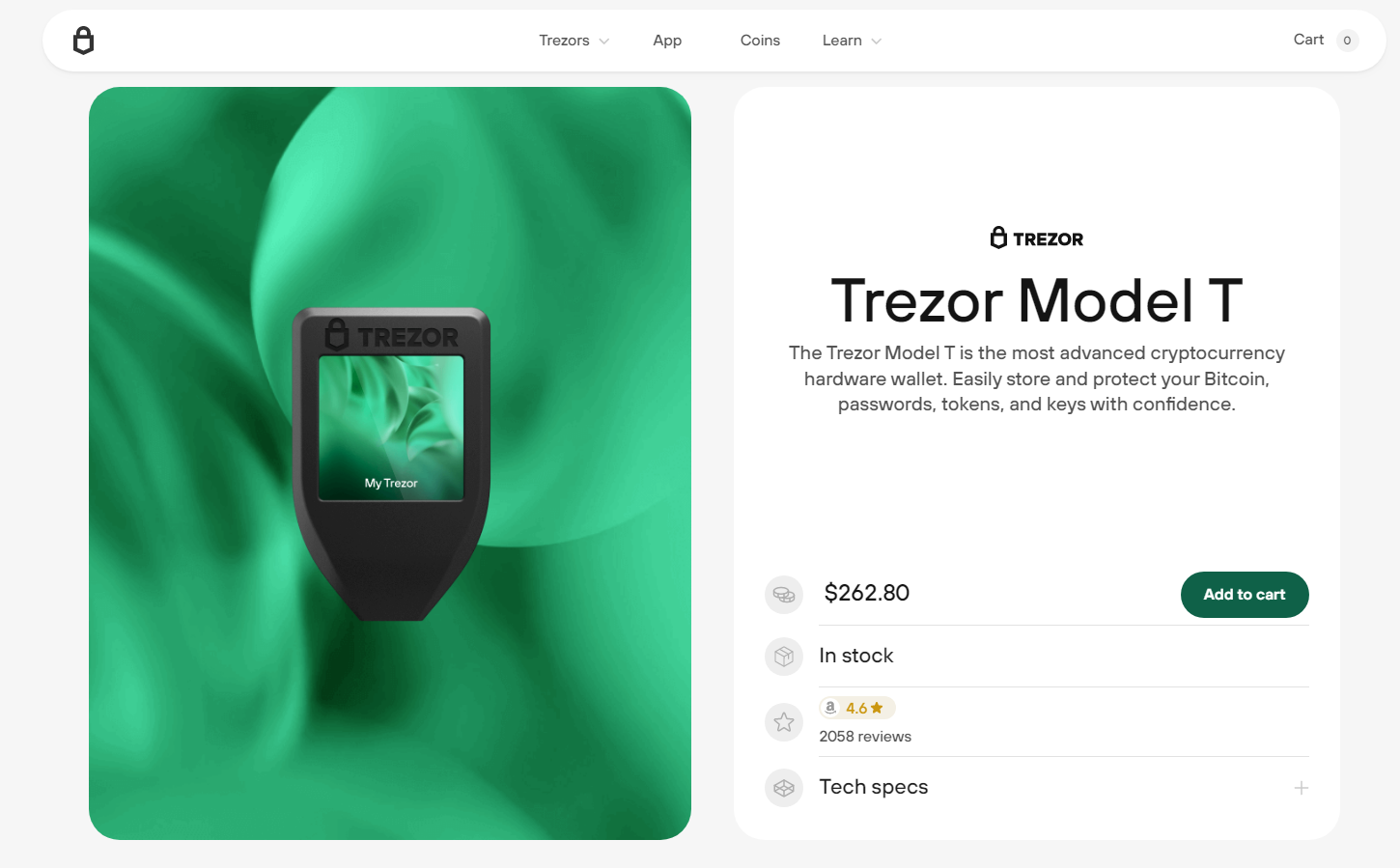
Although the touchscreen and explainable storage are the primary purchasing factors for the Model T, the hardware wallet supports a few other exciting features, like the ability to anonymize Bitcoin transactions through Coinjoin and the option to increase security by using Shamir backup.
In our opinion, the Trezor Model T is arguably the best-equipped crypto wallet on the market. However, with the device costing nearly double the price of a Ledger Nano X and four times more than the Trezor Model One, the additional features will only appeal to larger investors looking for cutting-edge security features.
Trezor Model T Pros:
- Advanced Shamir backup
- Anonymize BTC transactions
- Expandable storage
- Interactive touchscreen
Trezor Model T Cons:
- Higher pricepoint
- Supports fewer cryptocurrencies than the Ledger wallet
3. Ledger Nano S Plus
The Ledger Nano S Plus is the long-awaited upgrade to the popular Nano S series of Ledger wallets. While the two devices are similar, the Nano S Plus offers a few noticeable improvements over the legacy devices—not to mention it is a cheaper alternative to consider. Moreover, the Nano S Plus hardware wallet has increased storage space for up to 100 apps, unlike the previous generation of Nano S wallets, which hindered its useability.
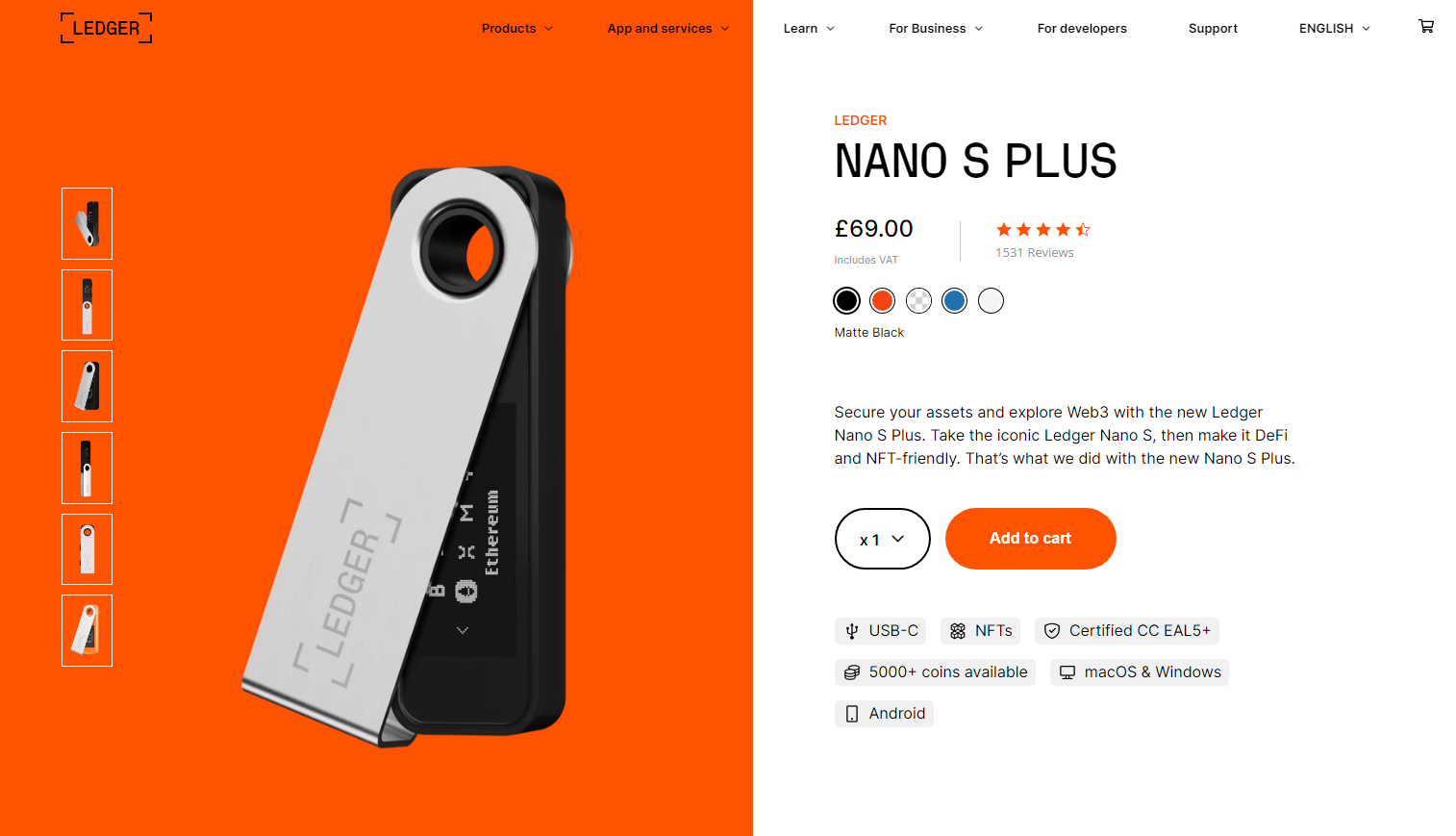
While the Nano S Plus doesn't include the same connectivity features as its more expensive counterpart, the device has opted to utilize the modern USB-C standard, improving its longevity. Similar to other wallets from Ledger, the Nano S Plus comes equipped with Ledger Live, providing the same cryptocurrency portfolio tracking and swapping features as the more expensive device.
The Ledger Nano S Plus costs $79, making it one of the cheapest hardware wallets available to investors who want to store their assets safely. Considering the device's impressive feature set and low cost, it's an excellent choice for anyone looking to switch to cold storage without outlaying a significant sum.
Nano S Plus Pros:
- Can store up to 100 apps
- Small device that can fit in a pocket
Nano S Plus Cons:
- Does not have wireless connectivity (cable only)
- The touch screen is small and difficult to read
4. Trezor Model One
The last of the mainstream wallets we'll discuss is the Trezor Model One, a budget hardware wallet designed to rival the Ledger Nano S Plus. Although the Trezor Model One offers primarily the same security features as the Model T, there are a few notable areas where costs have been cut. Firstly, the Shamir backup system has been cut, along with Coinjar transaction anonymization. Furthermore, the Model One features a smaller, non-touchscreen interface that instead utilizes two tactile buttons for navigation.
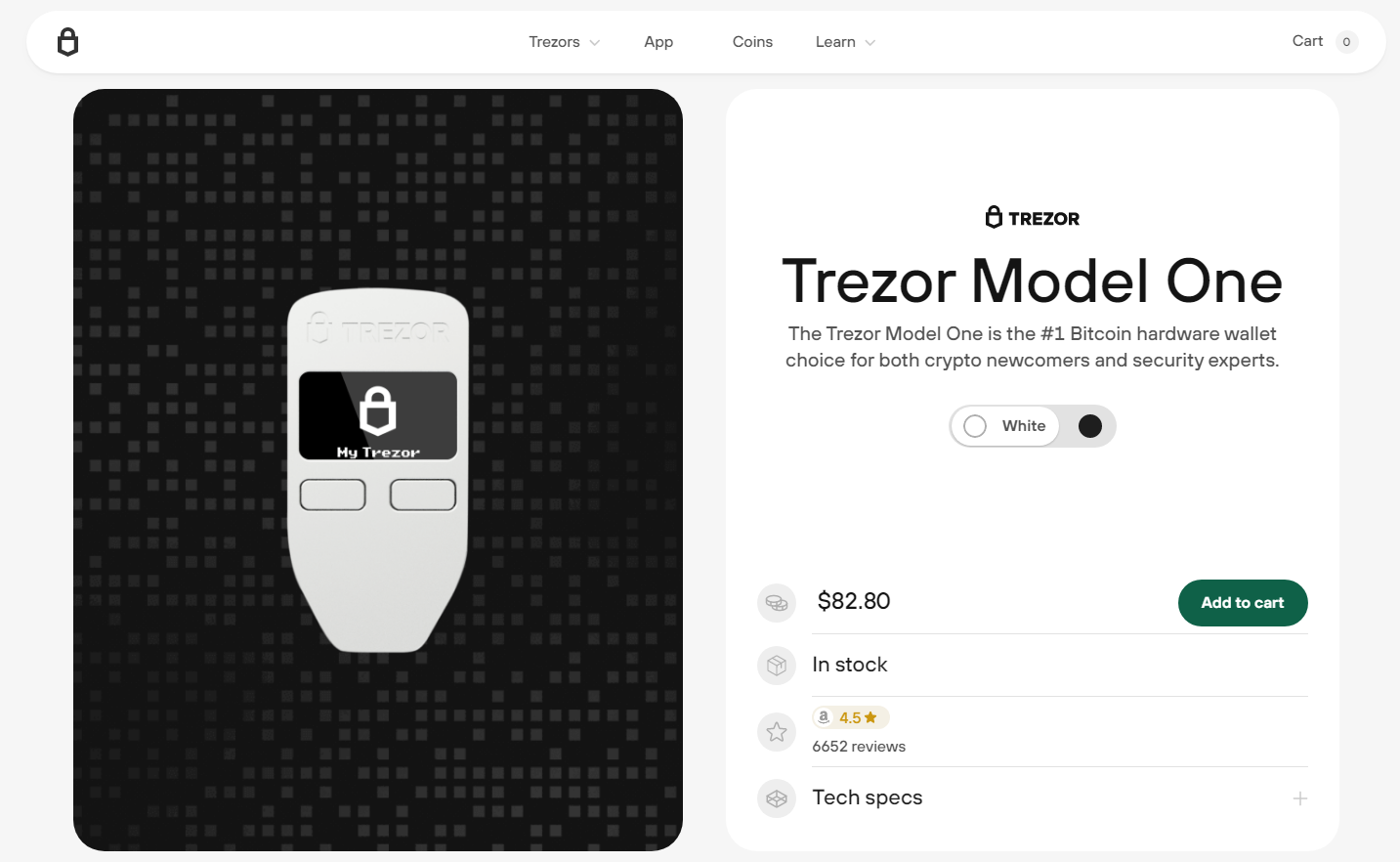
While the physical device has been changed significantly, the Model One still comes with the Trezor Suite app, which enables users to check crypto prices and exchange assets without using a third-party platform.
The most notable difference between the Trezor Model One and the Model T is the massively reduced price. While Trezor's premium offering costs an eye-watering $262.80, the Model One is much more reasonably priced at $82.80. Unfortunately, the device only supports 1,289 cryptocurrencies – almost 200 fewer than the Model T. Overall, the Trezor Model One is a solid budget choice and a strong competitor to the Ledger Nano S Plus. While the Trezor Model One offers support for fewer assets than Ledger devices, the improved usability is likely worth a few extra dollars for certain investors.
Read our full review of the Trezor Model One.
Trezor Model One Pros:
- Tactile and easy to handle
- Sufficient storage for apps
Trezor Model One Cons:
- Does not support a wide range of cryptos
- More expensive than a Nano S Plus in the budget range
5. Keystone Pro
The Keystone Pro is a unique crypto hardware wallet similar to a mobile phone. While Keystone is a lesser-known company than Ledger or Trezor, they've garnered a lot of attention by focusing on user experience and ease of use, making it perfect for users to store crypto.
Constructed primarily from fiberglass, the Keystone Pro features a 4-inch touchscreen and takes the shape of a mobile phone. As the device features no buttons, all operations are conducted by tapping on the screen. Although Keystone has taken a modern approach, the lack of a tactile option might be a con.
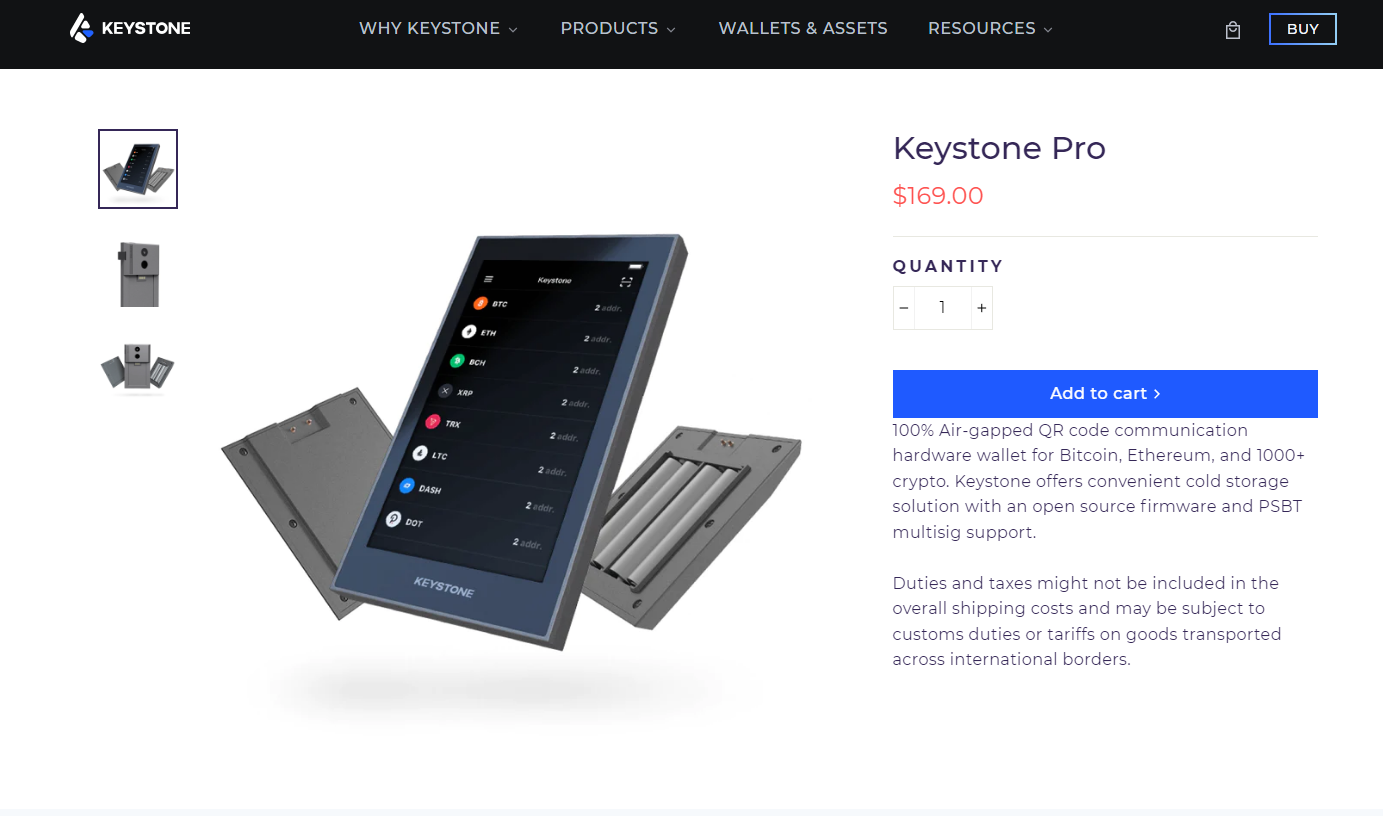
Like the previously mentioned Bitcoin wallets, the Keystone Pro utilizes a secure element chip to provide users with the highest encryption standard. Another feature that makes the Keystone Pro a secure crypto wallet is the inclusion of an anti-tamper mechanism that wipes the device in the event of theft or disassembly.
While it's standard for hardware wallets to commonly utilize pin codes for added security, the Keystone Pro features an embedded fingerprint scanner to provide quick access to the device. Furthermore, the Keystone Pro has rechargeable batteries and a rear camera that enables users to sign transactions by scanning a QR code, providing greater security.
The Keystone Pro is a more expensive option at $169 on our list. It only supports tokens created on 12 chains, so the device can only store a limited range of assets. However, the lack of token support could be a worthwhile trade-off for anyone looking to increase their security further.
Read our full review of the Keystone wallet.
Keystone Pro Pros:
- Large 4-inch touchscreen
- QR code support
- Fingerprint scanner to unlock
- Highly portable device
Keystone Pro Cons:
- Supports only 12 blockchain networks
- Fairly expensive given its feature set
6. BitBox02
The BitBox02 is an Open-Source hardware wallet that is usable on desktop computers and Android devices. It is a compact wallet similar in size to a Ledger Nano S Plus. While easily portable, the small size of the BitBox02 means that it could be difficult for people with larger hands to use the device.
Like most wallet software applications on the market, individuals with a BitBox wallet can download and install the BitBox app to monitor their portfolios and track crypto transactions to and from the device. The app is available on Android devices and enables users to buy crypto with fiat.
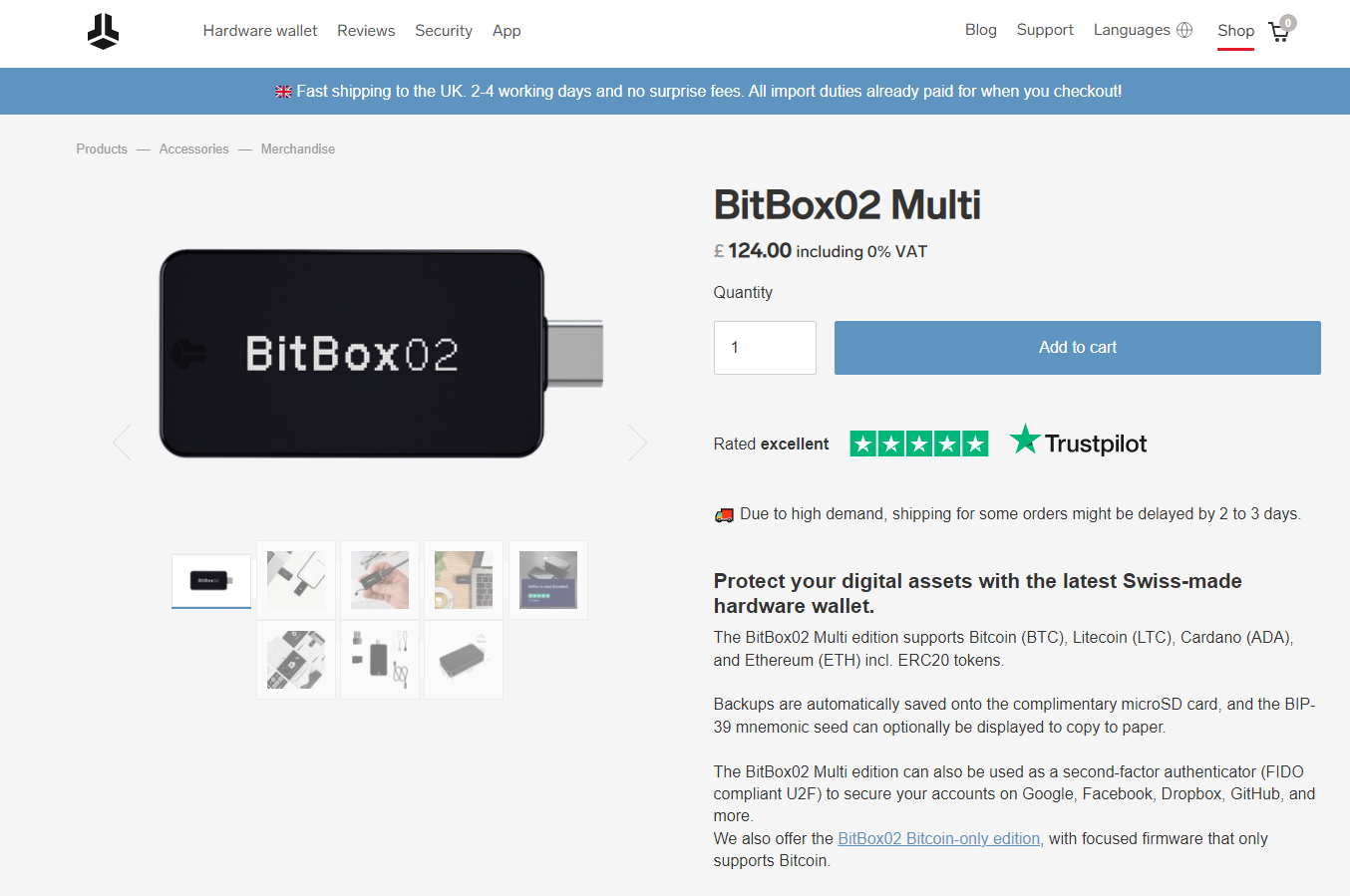
With the BitBox02 priced at $150, it's pricy given its comparatively limited feature set. However, with that said, the device offers a premium construction and expandable storage, which could be enough to convenience some investors to purchase the device. Furthermore, there is a Bitcoin-only version of the device for BTC purists.
The BitBox02 is a great hardware wallet with advanced security features and a beautiful design. Unfortunately, the wallet only supports Bitcoin, Litecoin, Cardano, and Ethereum-based assets. Investors looking to store tokens like XLM, which have a unique architecture, will need to select another hardware wallet.
BitBox02 Pros:
- Premium and quality designed device
- Open-source wallet
- It comes with SD card storage
BitBox02 Cons:
- A little expensive compared to other devices
- Limited cryptocurrency support
7. ELLIPAL Titan
The ELLIPAL Titan cold wallet is another phone-shaped touchscreen device. However, the ELLIPAL hardware wallet has added another level of security by eliminating any external connectivity. Despite looking similar to a mobile device, the ELLIPAL Titan has no USB, cellular, NFT, WIFI, or Bluetooth connectivity, which may initially seem like a con. Instead, all transactions are verified using the device's built-in camera located on the rear of the device. By taking this approach, ELLIPAL eliminates the chance of a digital attack.
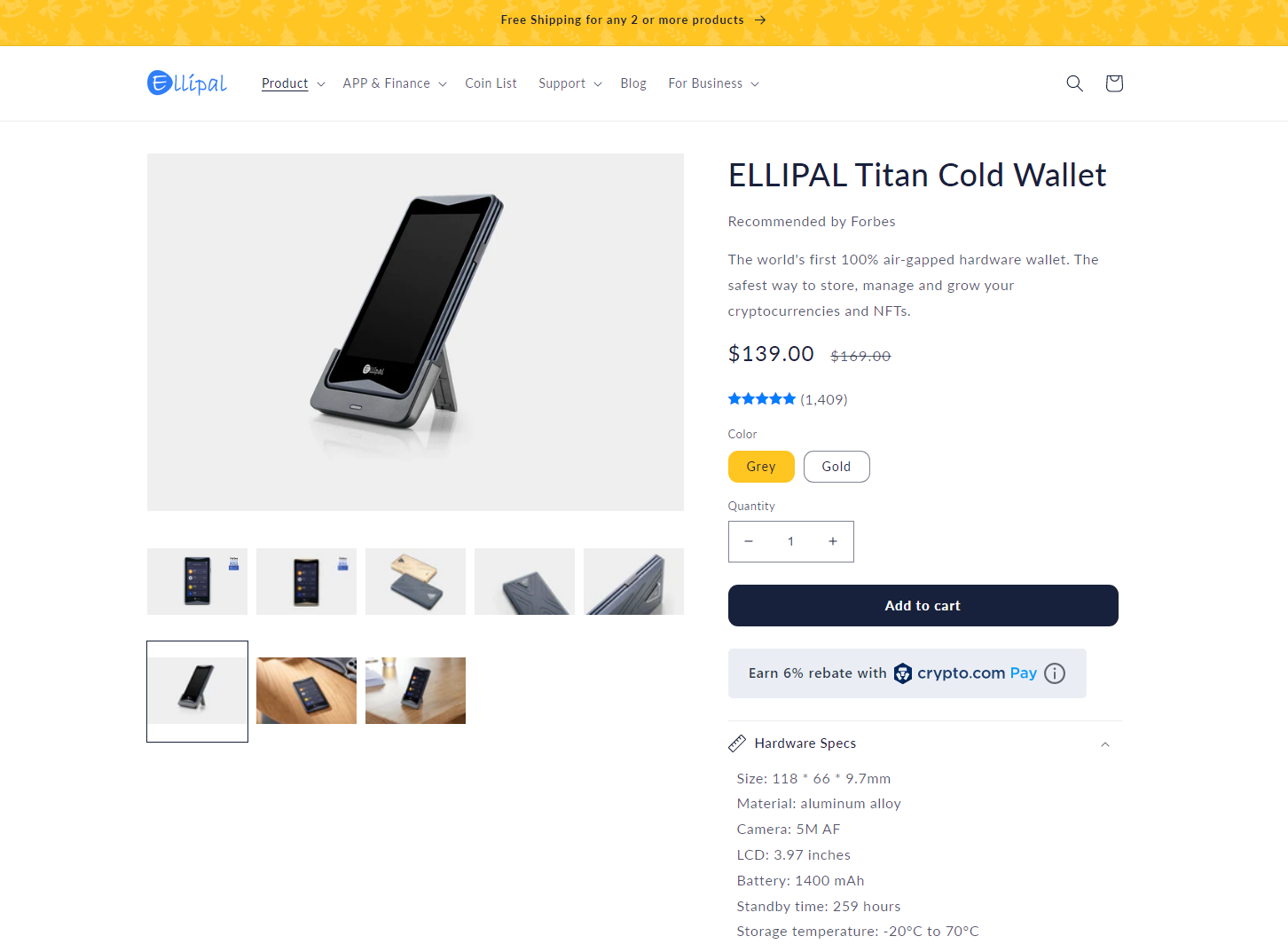
While the device offers little connectivity, it's still priced at $139. However, the costs are mostly justified with a 4-inch touchscreen and aluminium alloy construction providing a premium feel in the hands.
Users can store NFTs and over 10,000 crypto assets on the ELLIPAL Titan, making it an excellent choice to store many assets. However, the large size and desktop-only nature of the ELLIPAL hardware wallet might be cumbersome.
Read our full Ellipal Titan review.
ELLIPAL Titan Pros:
- Quality and responsive touchscreen
- No external connectivity to reduce technical attack
- More than 10,000 assets supported
ELLIPAL Titan Cons:
- Larger than competitor hardware wallets
- No mobile support
8. NGRAVE ZERO
Similar to the ELLIPAL Titan, the NGRAVE ZERO is a no-external connectivity cold wallet that lets users sign transactions by scanning QR codes using a camera. As there is no way to connect to the internet using an NGRAVE ZERO hardware wallet, users must sign transactions via QR codes generated by the propriety NGRAVE Liquid app, making any digital attack far more difficult to orchestrate. Additionally, the device boasts biometric security through a fingerprint scanner.
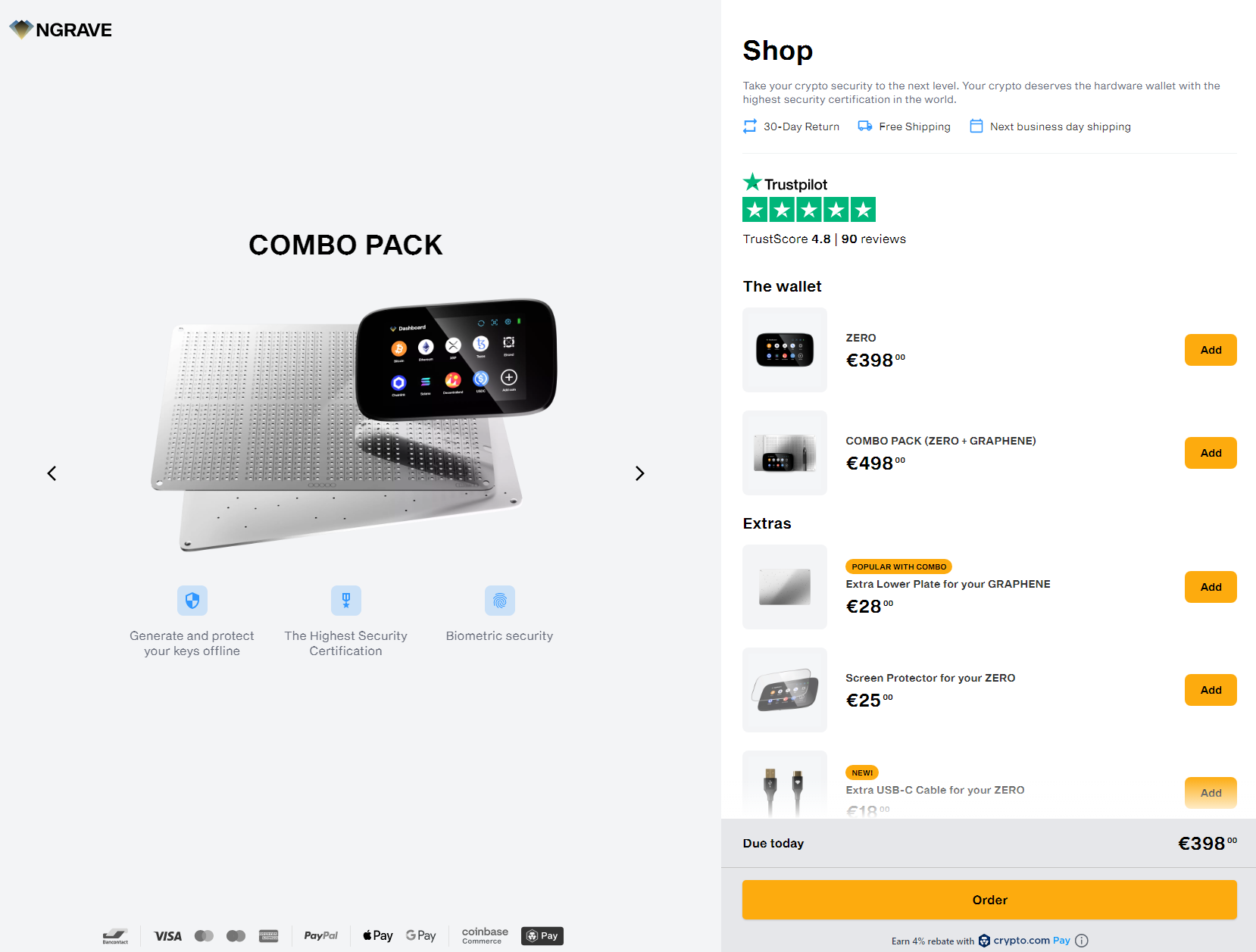
Because the NGRAVE ZERO requires an app, it requires a mobile phone to operate, potentially limiting its usability. Furthermore, it is similarly sized to a mobile phone, meaning it could be cumbersome.
The NGRAVE ZERO is the most expensive Bitcoin wallet on our list. While the device is designed well and features industry-leading technology, the $430 price tag makes it a difficult purchase, especially considering its similarity to the ELLIPAL Titan, which costs almost $300 less. Despite the NGRAVE ZERO supporting 13 different blockchains and working on adding support for more, the hefty price tag makes the device difficult to recommend for those on a budget.
NGRAVE ZERO Pros:
- Large 4-Inch touchscreen
- No external connectivity to reduce technical attack
- Supports 13 blockchain networks
NGRAVE ZERO Cons:
- Very costly compared to other hardware wallets
- Is dependent on a mobile device to operate
9. SafePal S1
The SafePal S1 is a credit card-sized hardware wallet with a small 1.3-inch screen and a five-button navigation system reminiscent of an old iPod. It is highly portable and has many security features.
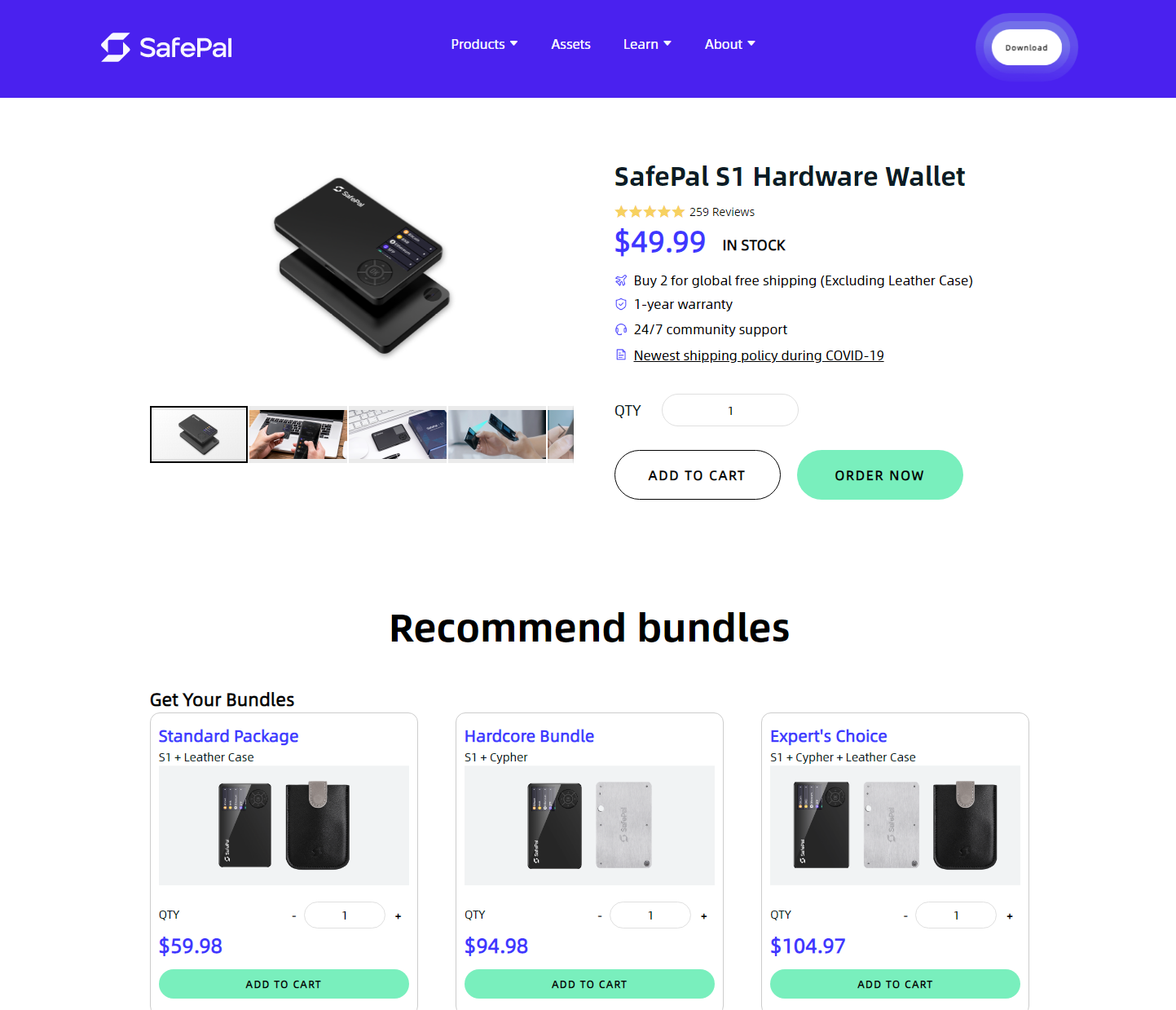
The device features a secure element chip, a true random number generator, and a mechanism to wipe the device if tampered with. Moreover, the SafePal S1 is entirely offline, with no WiFi, NFC, USB, or Bluetooth support, making it a 100% air-gapped hardware wallet.
Despite boasting a camera for scanning QR codes and supporting 54 blockchains, the SafePal S1 is one of the cheapest wallets on the market at just $49.99. While the build is primarily plastic and lacks a touch screen, the device is one of the cheaper options.
SafePal S1 Pros:
- Cost-effective hardware wallet
- Rear camera to scan QR codes
- 100% air-gapped security
SafePal S1 Cons:
- It does not have a touchscreen
- It can be cumbersome to hold and use
10. CoolWallet Pro
The CoolWallet Pro is one of the smallest hardware wallets on the market, weighing 6 grams and 0.8mm thick. Furthermore, with the device shaped like a credit card, the CoolWallet Pro is highly portable and surprisingly capable.
Encrypted Bluetooth makes connecting the CoolWallet Pro to a mobile device easy. Furthermore, the CoolWallet app, available on Android and iOS devices, enables users to buy, sell, trade, and stake crypto while on the go while still receiving exceptional protection.
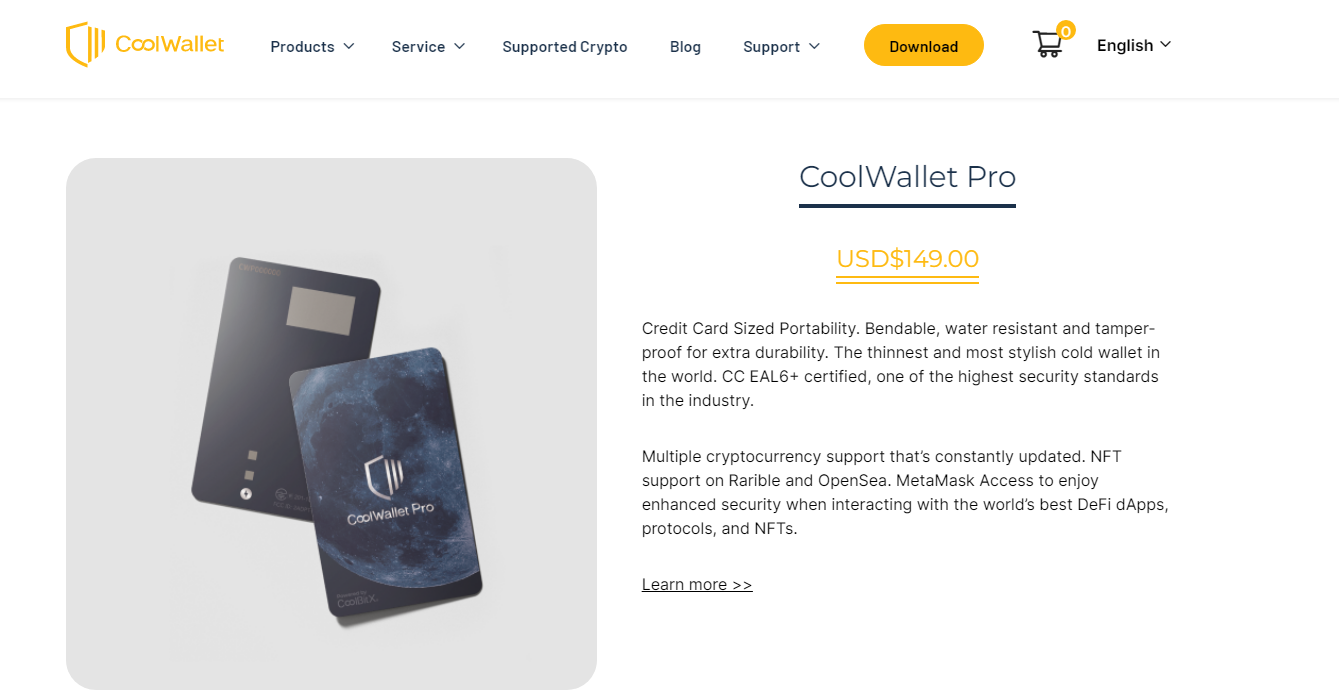
The durable, flexible, and easy-to-use cold storage device boasts improved features compared to its predecessor model. It is an advanced Bitcoin hardware wallet with cutting-edge software, increased security, and the ability to earn free crypto through staking Proof of Stake (POS) coins such as Cardano. The CoolWallet Pro is an advanced Bitcoin hardware wallet with an excellent mobile app.
Like the Ledger Nano X model, the CoolWallet Pro has Bluetooth connectivity to pair with Android or iOS mobile devices within a 10-meter range. The interface to the user's mobile phone acts as a 2FA device for enhanced security that supports biometric login. Crypto investors can trade, exchange, check balances, and swap crypto from a cold storage device to verify the transaction.
While the device offers support for 27 blockchains, including NFTs, priced at $149, the CoolWallet Pro costs around three times as much as the SafePal S1 and lacks the features to justify the increased cost. However, the CoolWallet Pro could still provide value to investors looking for the thinnest possible hardware wallet.
Read our full review of the CoolWallet Pro.
CoolWalletPro Pros:
- Lightweight and portable
- Great security and encryption
- Mobile app is well-designed and intuitive
CoolWalletPro Cons:
- Quite expensive compared to other hardware devices
- Requires connectivity to a mobile phone
11. KeepKey
Rounding off our list of the best hardware wallets is KeepKey, a cold storage wallet designed for use with a desktop computer or laptop. While the KeepKey hardware wallet features a large screen, users interact with it via a tactile button on the top of the device. While a touch screen would be nice, the sizable screen makes confirming transactions a breeze.
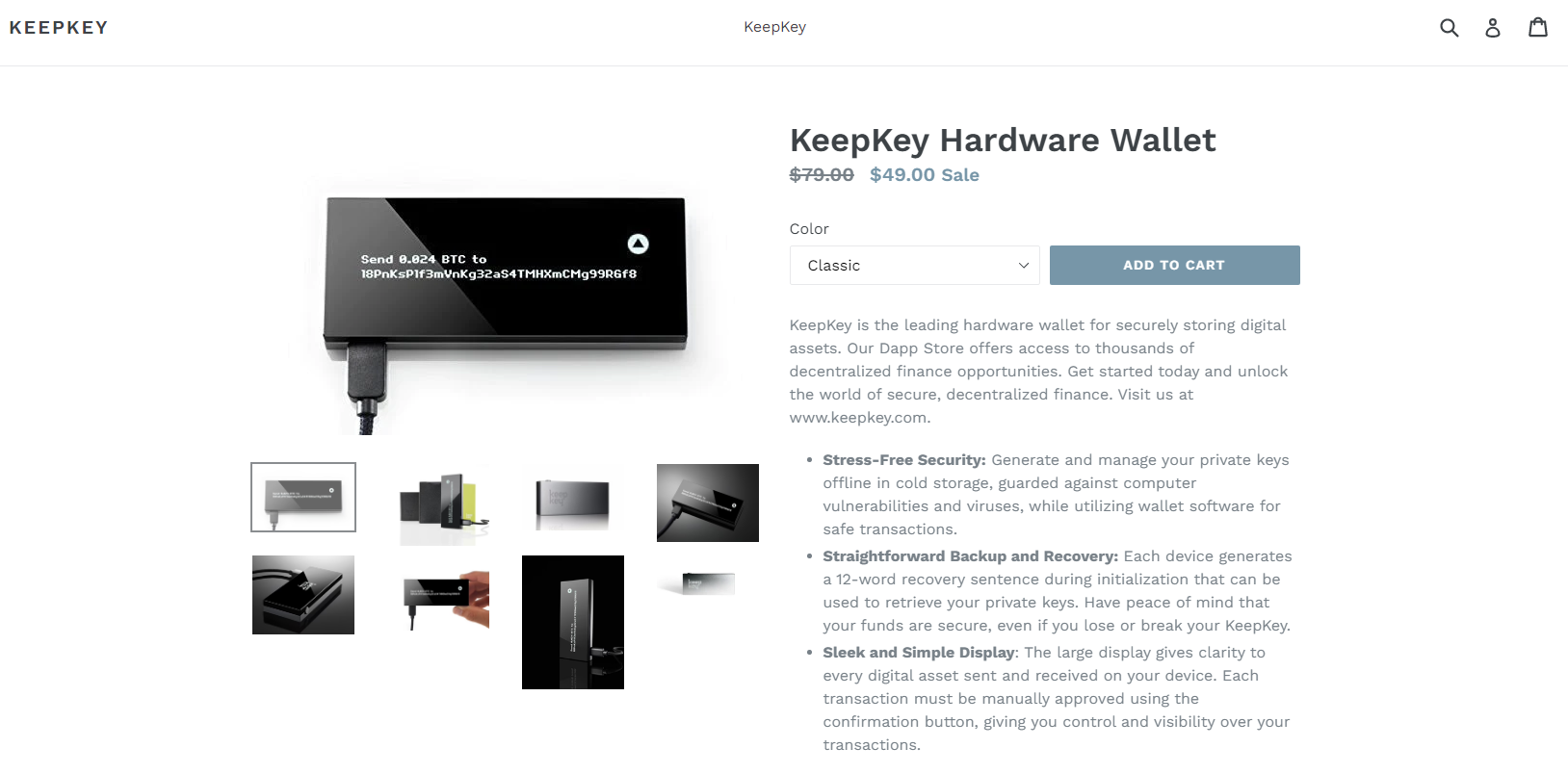
The KeepKey hardware wallet features no OS, meaning it's not susceptible to malware or viruses. However, with the device only generating a 12-word code that can be used to recover lost or stolen Bitcoin, it is technically easier to compromise than devices like the Ledger Nano X, which offers the option of a 24-word recovery code.
Although the KeepKey wallet is reasonably priced at $49, its low cost is reflected in its features. However, with the device supporting 2,534 assets, it could be worth considering for investors who are okay with a basic feature set.
KeepKey Pros:
- Low-cost hardware wallet
- Large screen to operate
- Not vulnerable to viruses
KeepKey Cons:
- Only 12-word recovery code for backup
- Lacks advanced features
How to Pick the Best Hardware Wallets for Your Needs
Picking the top crypto hardware wallets doesn't have to be difficult. We've summarized a few important considerations to help make selecting the best hardware wallet a breeze.
- Supported Assets – Considering the number of assets supported by a hardware wallet is crucial for investors looking to store a diverse range of crypto assets. While most wallets will support Bitcoin, Ethereum, and the other most popular cryptos, some do not support assets like XLM, which use an alternative architecture.
- Storage – Some hardware wallets, like the original Ledger Nano S, had extremely limited storage, meaning users could only store 4-5 different assets on the device, greatly hindering usability. Therefore, to ensure that a user doesn't have to purchase a secondary hardware wallet, it's advisable to check the storage offered by a device and compare it to the number of assets an investor wishes to store securely.
- Purchase Price – In contrast to software wallets, hardware wallets cost money. The price of a hardware wallet device can differ significantly based on features, brand, and location. To ensure that a user gets the most out of their money, carefully comparing the purchase price to the features offered is vital when buying a hardware wallet.
- Track Record – Another critical factor to consider when selecting the best hardware wallet is the company/device's track record. It could be worth avoiding a hardware wallet if a company has previously had security issues or controversy.
- Ease of Use – Some cold storage devices are complex, making them inefficient for daily use. A simple user interface is necessary for anyone wishing to perform transactions frequently. Additionally, it can be worth considering a device's desktop app performance and whether it supports Android and IOS devices.
- Additional Features –Although security and ease of use are arguably the most important factors when selecting the best crypto hardware wallets, additional features are also worth considering. For example, some devices, like the Ledger Nano X, offer support for NFTs and in-built exchanges and swap services, making using a hardware wallet much more pleasant.
Frequently Asked Questions
Is a Hardware Wallet Worth It?
While not a strict requirement, a hardware wallet is the safest way to store cryptocurrency. As such, the devices have become extremely popular with security-conscious investors. Generally speaking, the additional security features are worth it for anyone wishing to safely hold digital assets for prolonged periods.
Why Use a Hardware Wallet?
Due to the increased cost associated with cold wallets, it can be difficult to determine whether they're worth using. However, for anyone wanting to store bitcoin or another cryptocurrency for a long period, there is no alternative. Hardware wallets provide unparalleled security features and are a must for investors that want complete control over their funds.
What Happens if a Hardware Wallet is Stolen?
If a hardware wallet gets stolen, it's not the end of the world. Generally, a hardware wallet requires a unique pin to be entered before its possible to access the device; without the pin, nobody can gain control over the coins stored within it. Furthermore, every hardware wallet has a private key (typically 12 or 24 words) used to recover the wallet from another device.
What is Hardware Wallet?
A hardware wallet sometimes referred to as a cold wallet, is a device that enables people to store crypto assets securely. In contrast to a software wallet, a hardware wallet is a physical device that provides an additional layer of security. Most hardware wallets are about the size of a USB memory stick and either feature a USB connector or Bluetooth connectivity.
Is a Hardware Wallet More Secure than a Hot Wallet?
While hot wallets can be non-custodial (meaning that its owner controls the private keys), they are connected to the internet and software-based, meaning they are susceptible to digital attacks. However, as a hardware wallet features encryption technology that requires the device to be physically present, they do not have a single point of failure. As such, they are the most secure way to store crypto.
Final Verdict: The Best Hardware Wallet
While each of the hardware wallets we've looked at offers a good mixture of features, security, and usability, a particular option offers the best performance price.
The Ledger Nano X is an extremely capable hardware wallet that is portable, feature-rich, and budget-friendly. At $149, it was the cheapest of the premium offerings we've discussed. With Bluetooth connectivity, a 100mAh battery, and support for more than 5,500 digital assets, the Ledger Nano X is the most versatile hardware wallet currently available and a better alternative to keeping crypto on exchanges.


